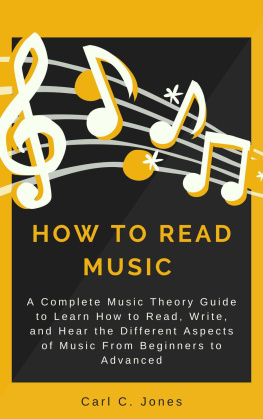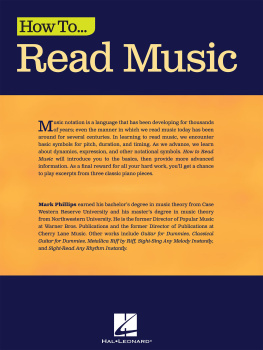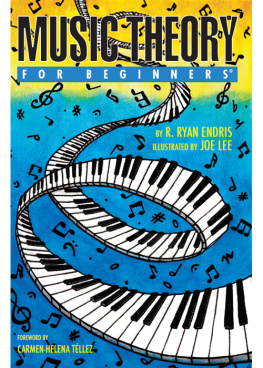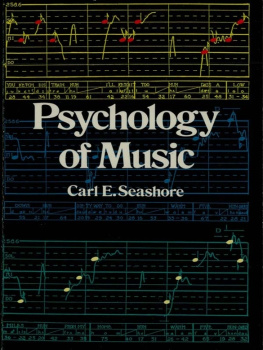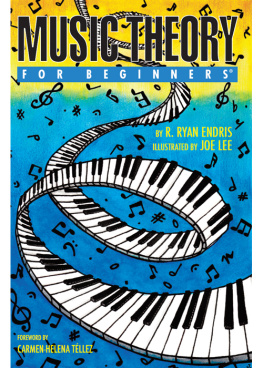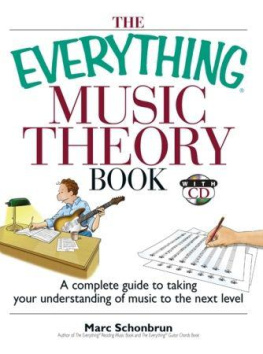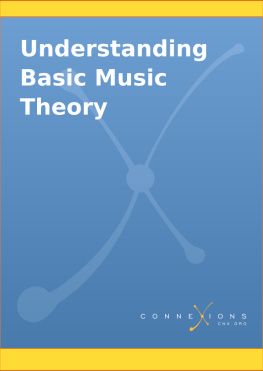How to Read Music
A Complete Music Theory Guide to Learn How to Read, Write, and Hear the Different Aspects of Music from Beginners to Advanced
Table of Contents
M usic is an art form of combining different sound notes to express feelings, ideas and emotions by using the elements such as harmony, rhythm, color and melody. The essence of music fulfills a variety of purposes in our daily life: aesthetic pleasure, during ceremonies, religious practices, or as a source of entertainment.
Youre here because you want to make awesome melodies while you probably dont know much yet about music theory.
This book skims over the most important topics and explains the essential basics that gives you the most profitable results. Make no mistake, you do have to know a couple of important basic topics to have a musical structure to follow.
Whether youre just playing an instrument or youre using software as a music producer, for the sake of practicing the material, it doesnt really matter. Just do it when you can. How you do it, is up to you.
Throughout this book, the readers will learn about the different methods of reading the various notes of sound. This book aims to develop an interest in the minds of the readers regarding the beauty associated with the different sounds, and also enable them to understand the wide variety of musical compositions available today.
If you want to learn to read music without wasting months or years on expensive music teachers, this book is perfect for you.
By actually applying the information right away, youll develop that deeper understanding quickly.
Chapter 1: The Fundamentals of Music
R eading music includes music theory and a comprehensive study about the methods of performance and practice.
Music Theory helps an individual understand the basics of music. The term, music theory refers to an academic study and a detailed analysis of the basic elements of music. Music is comprised of many elements: pitch, rhythm, pulse, melody, beat, harmony, voice allocation, texture, timbre, and many others. The kind of music describing various emotions is termed as dynamics or articulation. It also gives an idea about the varied concepts and descriptions of music across diverse cultures. The theory is based on the various practices observed by composers and musicians all over the world.
Music theory involves the study of the nature of the compositions and the mechanics involved in combining different sound notes. It identifies the techniques applied by the musicians and understands the various notations and languages used in the creation of music. The fundamental elements of music will be explained in detail in the subchapters.
The term, improvisation of music describes the development of music in a spontaneous manner. It is an act comprising techniques of impromptu compositions. These techniques are generally applied by the composers of genres such as blues, jazz fusion and jazz.
Composition is defined as creating recorded music through a medium that allows the listeners to interpret the music effectively. Compositions belonging to the western classical music serve as a basis of modern compositions across many cultures.
The term interpretation refers to the process adopted by a performer to perform the musical compositions that have been created earlier. Each individual can deliver the same composition in his or her unique way.
Notation is defined as the process of writing sound notes and rhythms using various symbols. Writing music involves the notation of pitch, rhythm and instructions to perform the music. Each notation varies according to the style of the music and the age or time period during which the music is created.
The subchapters on this topic will highlight the elements of music and their significance.
P itch is a measure to classify the quality of sound relatively as low or high. This measure considers the frequency of vibrations created by sound waves. Frequency is defined as a scientific unit of measuring sound.
The term pitch standard is regarded as a reference pitch on the basis of which the instruments are tuned during a performance. A standard of 440 Hz is set for the keyboard note with letter A placed above the middle of the letter C. This value is considered to be the conventional reference pitch.
An octave is the measurement of the interval between tones. In music, a perfect octave includes the distance between one musical tone and another equaling double or half the frequency. For instance, one note measures 440 Hz and the other tone is equal to 880 Hz; thus, the ratio of 2:1 is defined as the octave for the particular sound note. The octave, i.e. second tone, is the resultant of rapid vibrations thereby generating a pitch higher than the first tone.
Musical notations, when written down, are displayed on a staff, i.e. a combination of spaces and lines that help the performers learn at what pitch they should play the particular musical composition. The notes of the keyboard denoted by letters and their respective hertz numbers are displayed on the musical staff as shown in the image below.

Timbre: The colored sound tone
T imbre refers to the quality of sound that helps a listener understand the differences in the tones of a sound note. It is a factor to differentiate between many musical sounds having the same level of loudness or pitch. This factor of sound takes into account the harmony created by a note and dynamic vibrations of the various musical notes. For instance, a piano and a guitar play the similar notes at the same level of loudness. The performers can understand the difference between the instruments due to the difference in the level of timbres produced.
Next page
